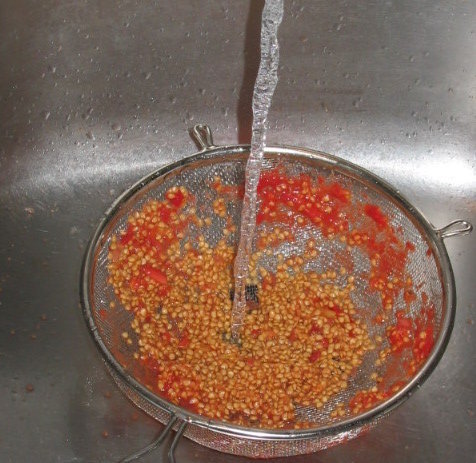Back to September 2017 Newsletter
Seed Cleaning 101

Bob Wildfong
Well cleaned seeds are separated from the pulp and chaff that they grew with, which can absorb water and make the seeds mouldy. Well cleaned seeds take up less space, because you only store the seeds, not bits of leaves, petals, stems, and pods that serve no purpose anymore. And if you clean your seeds well you can even improve their germination rate, because you remove the unpollinated and unformed seeds that won't sprout.
There are many methods for cleaning seeds, mostly depending on the species. We like to break them down into three main techniques using water, air, and screens.
Water
Seeds that come in wet fruit, such as peppers, melons, squash, and tomatoes, are often easier to separate from their pulp if you add water. Have you ever pulled the seeds from a halloween pumpkin? The seeds stick all over your hands, and they're hard to separate. But if you scoop the pulp and seeds into a bowl of water, it's easy. The seeds even float to the top, and they don't stick.
See our handout on saving tomato seeds for a good explanation of how to use water to clean seeds.
Air
About 90% of all seeds don't come in wet fruit though. Beans and peas, greens like spinach and lettuce, all grains, and most flowers and herbs are ripe when their pods or seed heads are brown and dry. When you harvest them, you might have to crush or rub the seed heads to remove the seeds (for example, from ripe bean pods) but then you always get a mixture of seeds with bits and pieces of other things. Broken pods, bits of stem, flower parts, or broken flower capsules. How can you separate the seeds out easily?
The easiest way is usually to use air. Blow away the stuff you don't want. It works because, for most species, the seeds are the heaviest thing in the mix. Put the seeds and chaff in a wide, shallow bowl and blow on it gently (If you use a deep bowl, you'll find out why you shouldn't when the light bits and pieces fly straight up in your face). With a little shaking, stirring, and practice you can blow out most of the chaff while keeping the seeds in the bowl.
To scale up the technique, set up an electric fan on the edge of an outdoor table. Place a large bin beneath the fan, and slowly sprinkle your seeds so they fall into the fan's airstream and fall into the bin. The heavy seeds should land in the bin, but the lighter chaff will blow away.
Screens
Finally, impress your friends with your enviable assortment of kitchen screens. Seed savers collect sieves, collanders, and strainers of every size from dollar stores and thrift stores, searching for mesh sizes that they haven't found yet. The reason is that every species of seed is a little different in size, and it really helps to match just the right screen with just the right seeds.
The trick is to find a screen whose mesh is just a little smaller than the seeds you want to clean, and a second screen that is just a little bigger. One will allow the small, dusty stuff to fall through but not the seeds. The other will allow the seeds to fall through, but not the larger stuff.
Say you have a handful of recently saved lettuce seeds, nicely dried and rubbed so the seeds and chaff are all loose but hopelessly mixed together. With the right combination of screens you can put that mixture on one screen that allows the seeds to fall into a bowl, but filters out the larger stems and leaves. Then pour the seeds on a screen that keeps the seeds but allows the dusty pieces of fluff to fall through. Not only do you wind up with seeds that are much cleaner (a few puffs of air will finish the job) but you will probably have also removed the thin, unpollinated seeds that didn't form properly. Those would not have sprouted, so you will have actually increased the germination rate of your seeds!
Learn more about saving seeds, and how to clean each species in our handbook "How to Save Your Own Seeds".
**
Bob Wildfong is Seeds of Diversity's executive director
Not yet a member?
An annual membership to Seeds of Diversity gives you access to our seed exchange, seed grow-out programs, and our online news.

We depend on donations to do our work.

Thank you for your support!
